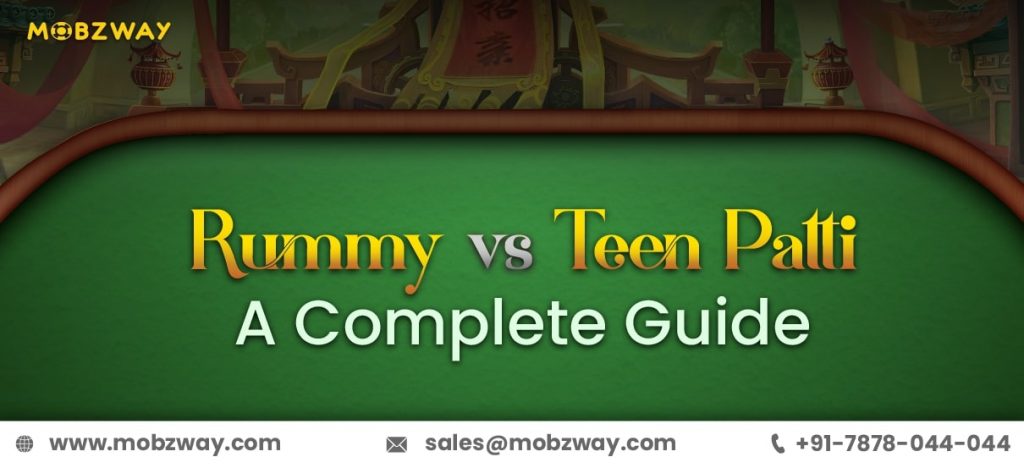Contact Us
Introduction
Rummy is one of the most popular card games globally, blending skill, strategy, and a touch of chance. Whether played offline with friends or digitally online, the objective remains the same—form valid sets and sequences before your opponents. Over time, the game has evolved into engaging variations like Points Rummy, Pool Rummy, and Deals Rummy, captivating players of all ages. With the rise of smartphones and mobile apps, rummy has reached new heights, making online rummy a booming industry with millions of players and lucrative opportunities for entrepreneurs and gaming firms. If you're planning to launch a rummy game app, you're stepping into a thriving market where your success depends on delivering a seamless gaming experience, secure payment options, and compelling features. This guide will walk you through every stage of rummy game development, from understanding the basics to creating a high-performing, user-focused product—so let’s dive in.
What is Rummy Game?
Rummy is one of the traditional card games which is played by 2-6 players. Every player is normally given 13 cards to start with and the ultimate goal is to form valid sequences and sets using the cards. A sequence is any set of consecutive cards of a suit and a set is any set of cards of the same rank but of different suit. The first person to organize his/her cards and to declare wins the game.
Rummy A standard game of rummy may be played with one or more decks of cards, including jokers, as wild cards. The beauty of rummy is that it has a simple and strategic game play, and a combination of planning, observation and decision making is very important in it.
Rummy is an international game, and there are enormous numbers of users in India, Europe, and the United States. The online rummy market is already growing fast in India alone with a total market size of $335 million set to increase to $1.4 billion. The online gambling sector which includes card games such as rummy is expected to hit an all time high of 182.21 billion dollars by 2030 across the globe.
This increase in popularity has caused a spurt in the development of rummy games, with more businesses venturing into monetization by use of in-app purchases, advertisement, and subscription. The rummy app is an intelligent choice in the current gaming market, as the app has a scalable potential and a high engagement level.
Key Features of a Rummy Game Development
To achieve a successful rummy game development, it is vital to incorporate as many features as possible to improve user experience, guarantee a fair game, and make the backend management easy. Such capabilities do not only make the players feel entertained but also enable game operators to control and expand their platforms successfully.
Essential Features
- Multiplayer Functionality: Allows playing a game in real-time with friends, relatives, or other users all over the world.
- Secure Payment Gateways: Facilitates smooth and safe real-money transactions and in-app purchases.
- Anti-fraud Systems: Protects the platform from cheating and ensures transparency and fairness.
- Rummy Variations: Includes popular versions like Points Rummy, Pool Rummy, and Deals Rummy for greater user engagement.
Advanced Features
- AI-powered Matchmaking: Matches players based on skill levels to ensure fair competition.
- Gamification: Adds fun elements like leaderboards, badges, rewards, and daily challenges to boost retention.
- Offline Mode: Allows users to play practice matches without requiring an internet connection.
- AR/VR Integration: Offers immersive gameplay experiences using next-gen augmented or virtual reality.
- Real-time Chat: Promotes player interaction and community building within the app.
Admin Features
- Analytics Dashboard: Provides real-time data and insights on user activity, gameplay trends, and engagement metrics.
- User Management: Allows admins to verify users, handle complaints, and take action such as banning or suspending accounts.
- Revenue Tracking: Displays earnings from in-app purchases, advertisements, and subscriptions.
- Game Customization: Offers flexibility to tailor gameplay rules, UI elements, and features based on geography or user behavior.
These features serve as the foundation for a well-rounded rummy game development project, combining user satisfaction with scalable backend control.
Step-by-Step Guide to Rummy Game Development
Developing a successful rummy game is a joint effort that combines imagination, game plan, technical skill and business acumen. The following is a step by step process, which defines every important step involved in the development of a strong and interactive rummy game application.
1. Research and Planning
The foundation of any rummy game begins with comprehensive research and planning. Developers must:
- Understand different game formats like Points Rummy, Pool Rummy, and Deals Rummy
- Analyze market trends and competitor offerings.
- Identify user expectations and regional preferences.
- Create a detailed development roadmap including budget, timeline, and tech stack.
This phase helps define the project scope and ensures that development aligns with business goals.
2. Game Engine Development
The game engine is the core of rummy game development. It must manage:
- Card shuffling and distribution
- Game logic and rules
- Real-time multiplayer interactions
- Scoring, time tracking, and error handling
Recommended technologies:
- Front End: React, Angular (web); React Native or Flutter (mobile)
- Back End: Node.js, Laravel, Python
- Real-time Communication: Firebase, WebSocket
- Game Engines: Unity, Unreal Engine, or lightweight options like Cocos2d-x, Phaser
- Languages: C++ for performance-critical modules
The right tech stack ensures smooth gameplay, cross-platform compatibility, and reduced development time.
3. Designing the Game Interface
UI/UX plays a crucial role in engaging players. While designing the interface:
- Keep the layout clean and intuitive
- Highlight essential game elements like cards, turns, and scores
- Integrate smooth animations for shuffling and dealing
- Support device responsiveness across mobiles, tablets, and desktops
- Enable customizations for avatars, themes, and backgrounds
- Incorporate live chat or voice interaction for real-time engagement
The interface should be fast-loading and lag-free, ensuring a premium experience for casual and competitive players alike.
4. Implementing Security Features
Security is critical for building player trust and complying with gaming regulations. Key measures include:
- SSL/TLS encryption for data protection
- RNG (Random Number Generator) for fair shuffling
- Anti-fraud algorithms to detect bots or account abuse
- Multi-factor authentication (MFA)
- End-to-end encrypted communication between players and servers
- Regular audits and vulnerability testing
These features reinforce platform integrity and ensure compliance with regional gaming laws.
5. Payment Gateway Integration
Monetization is a core goal in rummy game development. Selecting the right payment gateway is essential:
- Support multiple payment modes: credit/debit cards, UPI, e-wallets, net banking
- Ensure PCI-DSS compliance and SSL encryption
- Provide quick deposit/withdrawal mechanisms
- Support global currencies and regional regulations
Popular gateways include Stripe, PayPal, Razor pay, and Paytm. A seamless payment flow boosts user trust and retention.
6. Testing and Bug Fixing
Before launch, thorough testing ensures quality and performance:
- Functionality testing: Check gameplay, scoring, payments, and user interface
- Compatibility testing: Test across browsers and devices
- Network testing: Simulate slow or unstable internet conditions
- Bug fixing and regression testing: After each update
Ongoing QA even post-launch ensures the app stays polished, secure, and enjoyable.
7. Launch and Marketing
Launching the game strategically is as important as developing it:
- Begin with a soft launch in selected regions to gather real-user feedback
- Enhance store listings through keywords, images and interesting description
- Open Google Play and Apple App Store
- Market digitally: optimization, paid advertisement, collaborations with influencer
- Welcome bonuses, free tournaments and referral offers can attract the first users
An aggressive marketing will assist in creating downloads, gaining brand trust and establishing a loyal fan base.
How Much Does It Cost to Develop a Rummy Game?
Rummy game development can be very expensive or very cheap depending on the complexity of the features that one wants to have on the game, the size of the project and the number of platforms that one wants to run the game on. The very basic rummy app with minimum functionality might cost between 5,000 to 35,000 dollars and a complex one, which is scalable and supports the functionality of real-money gaming along with the sophisticated UI/UX might cost even more.
There are a number of factors affecting the total development cost:
- Platform: The development process is also expensive because developing three platforms at once requires cross-platform optimization.
- Features: payment integration, gamification elements, and RNG certification, anti-fraud systems, and real-time multiplayer increase the cost of development
- Design: Custom UI/UX, good graphics and responsive interfaces need extra spending.
- Team Size: The increased size of the development teams that include specialists (UI/UX designers, game developers, testers) affects the total budget.
- Development Time: More complex features and broader gameplay modes extend development timelines, increasing the cost accordingly.
The business can tailor its rummy game development roadmap to meet its budget, features need, and target audience at Mobzway and achieve maximum ROI at minimal cost without compromising the quality of the game.
Conclusion
The development of Rummy games does not only concern the creation of an exciting card game; it is also associated with absolute conformity to the legislative system and industry norms. The whole process should be done with accuracy starting with getting the necessary gaming licenses to incorporating KYC and responsible gaming features.
We make this complicated process easy at Mobzway. Our high-qualified team will make sure that your rummy platform is safe and scalable, and at the same time, it will be entirely compliant with regional and global gaming laws. We are committed to fair play, player safety and sustainability of the platform long-term.
In case you plan to start your own online rummy portal, tie up with Mobzway to make your dream come true-legally, professionally and profitably.




